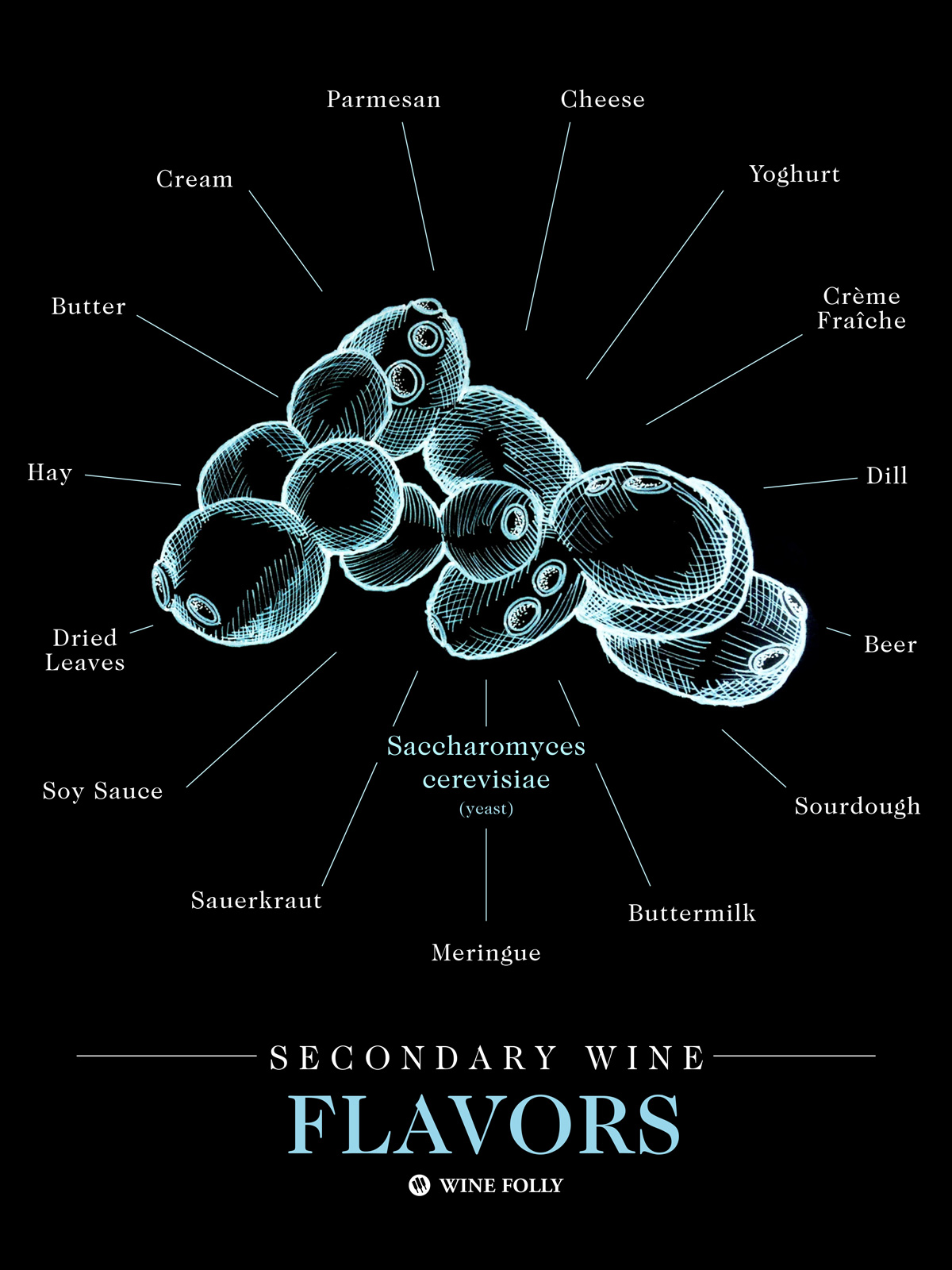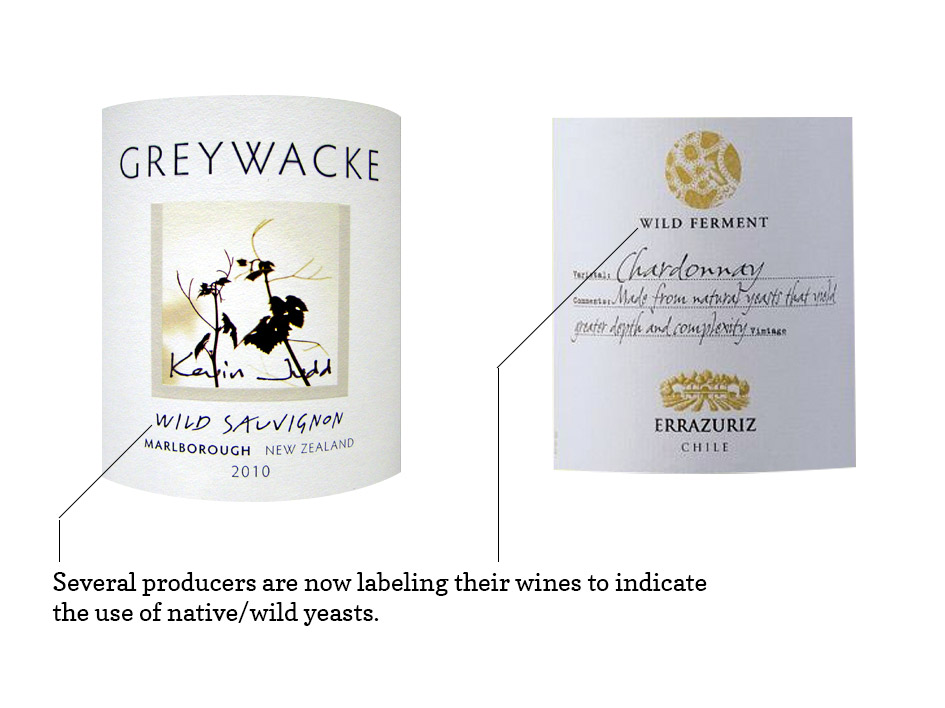So much of our understanding of flavor in wine comes from a focus on grapes, but there is another major ingredient involved in winemaking that greatly affects the flavor. Yeast.

Secondary flavors in wine are derived from yeast and winemaking microbes.
Yeasts are tiny single celled fungi that convert sugars into alcohol during winemaking (and beer making). The primary species associated with alcohol production is called Saccharomyces cerevisiae or, in Latin, “sugar-mold of beer.” In reality, however, there are thousands of different strains of yeasts that can be present during a fermentation; each can affect the resulting flavors of a wine.
“You can find 50,000 yeast particles on a single wine grape”-Carlo Mondavi, Raen Winery
The flavors added from fermentation are commonly referred to as “Secondary” flavors. Not only do yeasts have their own set of flavors, but they can also affect what primary flavors (e.g. flavors that come from the grape) are dominant in a wine. Additionally, certain yeasts produce wines with more oily or creamy textures where others produce wines with more spicy/sharp tastes.
Secondary Flavors derived from fermentation

- Creamy
- Cheesy
- Parmesan Cheese
- Greek Yogurt
- Lager Beer
- Sourdough Bread
- Dill Pickle
- Sauerkraut
- Buttermilk
- Meringue
- Butter
- Crème fraîche
- Hay
- Dried Leaves
- Soy Sauce
Selected Wine Yeast Strains
There are thought to be hundreds of strains of Saccharomyces and other yeasts used in winemaking. Here are a few species that are commonly known in winemaking:
Saccharomyces cerevisiae, Saccharomyces cerevisiae bayanus, Saccharomyces cerevisiae beticus, Torulaspora delbrueckii, Metschnikowia pulcherrima, Brettanomyces (most commonly considered a wine fault)
Where do yeasts come from?
Yeasts are all around us and they collect on wine grapes in the vineyard. So, if you were to pick grapes and mash them into a 5-gallon bucket, they would start to ferment. This is undoubtably how wine first came to be. Of course, it might not finish fermenting due to the wild yeasts’ ability to survive in the alcoholic environment. This is where commercial yeasts come in. There are a handful of major brands that specialize in creating yeast blends that have been carefully selected to be ideal for specific types of wine or to handle specific winemaking conditions.
Commercial Yeasts
When commercial companies began to produce yeast, the focus was on successfully fermenting wine. Back then (and still in many places today), winemakers had a lot of problems with stuck fermentations. In fact, as the story goes, this was how White Zinfandel was first invented. Fortunately today, as we continue to improve and modernize winemaking, commercial yeast production has become more specialized. For example, in the catalog of the Canadian yeast brand Lallemand, you can find a yeast type isolated from the northern Sonoma region of Rockpile made specifically for Syrah. They also carry a Syrah yeast from the French Côtes du Rhône region (pdf ).
Over the years, winemaking schools have relied on commercial yeasts to educate new students and thus, a layer of trust has been built with commercial yeasts in modern winemakers. Despite the increasing array of commercial yeasts that have become available, many believe that reliance of commercial yeasts removes the individuality of a wine. There are a growing number of winemakers returning to the old tradition of creating their own custom “wild” yeast fermentations.
Native Yeasts
In times past, winemakers would pride themselves on the qualities of their cellars for making wine. It wasn’t necessarily the cellars that were great but the fact that the cellars and winemaking equipment were covered with unique blend of yeasts that would become an intrinsic part of the wine. Some producers would even go so far as not replacing equipment for fear of what it might do to the yeast population in their cellar. Today, independent wineries have better ways of producing and managing yeast. For example, the Italian sparkling winemaker Ferrari in Trento has perfected their Chardonnay yeast over years and the yeast blend could be considered a trade secret.
Some proof in the pudding: A study conducted in Macedonia on red wines found that wines made with locally isolated yeast strains produced red wines with higher polyphenols and antioxidants than wines made with commercial yeasts. While the study only demonstrated the value of local yeasts in a particular region (which could be an anomaly), it suggests that native yeasts may be better suited for wine production in their locality.
Last Word: Taste the Difference
Many producers are proud of their native yeast wines and will often indicate native yeast fermentation on the bottle. Taste the difference for yourself and seek out wines from the same region/producer with both native and commercial yeasts. You’ll be surprised by the remarkable difference between the two.

